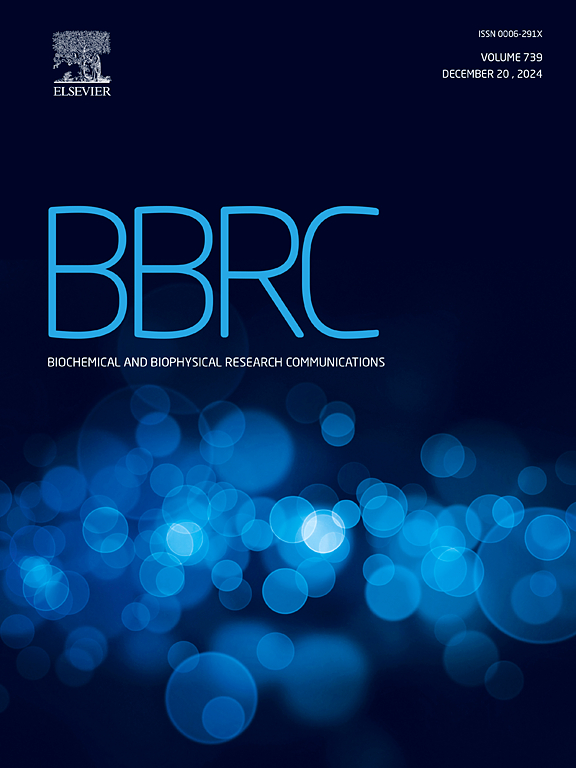Expression of fatty acid binding proteins in mesenteric adipose tissue
IF 2.5
3区 生物学
Q3 BIOCHEMISTRY & MOLECULAR BIOLOGY
Biochemical and biophysical research communications
Pub Date : 2025-01-20
DOI:10.1016/j.bbrc.2025.151346
引用次数: 0
Abstract
Adipose is a complex tissue comprised of adipocytes, immune cells, endothelial and progenitor stem cells. In humans, there are at least nine defined adipose depots, each containing variable numbers of genetically identified adipocyte clusters suggesting remarkable heterogeneity and potential functionality in each depot with respect to lipid metabolism. Although subcutaneous and visceral depots are commonly analyzed for biochemical and molecular functions, the mesenteric depot has been overlooked yet strongly implicated in lipid mediated immune surveillance. Since fatty acid binding proteins (FABPs) are primary cellular conduits to lipid trafficking, we evaluated the expression patterns for four major fatty acid binding proteins (FABP1, FABP3, FABP4 and FABP5) using a combination of gene expression, immunoblotting, and immunofluorescence in mesenteric fat from both young and old, male and female C57Bl/6J mice. All four FABPs were expressed at the mRNA and protein level in murine mesenteric adipose tissue. While there was no statistical change in expression of mesenteric FABP isoforms with sex or age, the expression of mesenteric FABP1 was increased, and FABP4 decreased, in both males and females as compared to perigonadal and inguinal depots. Surprisingly, immunofluorescence staining revealed that compared to subcutaneous or perigonadal depots, mesenteric fat expresses FABP3, but little FABP5, in adipocytes. These results highlight the diversity in adipose tissue and the importance of evaluating the mesenteric depot in the context of lipid transport and metabolism.
脂肪是由脂肪细胞、免疫细胞、内皮细胞和祖干细胞组成的复杂组织。人类至少有九个明确的脂肪库,每个脂肪库都含有数量不等的经基因鉴定的脂肪细胞集群,这表明每个脂肪库在脂质代谢方面都具有显著的异质性和潜在功能。虽然皮下和内脏脂肪库通常被分析为具有生化和分子功能,但肠系膜脂肪库一直被忽视,却与脂质介导的免疫监视密切相关。由于脂肪酸结合蛋白(FABPs)是脂质运输的主要细胞通道,我们采用基因表达、免疫印迹和免疫荧光相结合的方法,评估了四种主要脂肪酸结合蛋白(FABP1、FABP3、FABP4 和 FABP5)在年轻和年老、雄性和雌性 C57Bl/6J 小鼠肠系膜脂肪中的表达模式。这四种 FABPs 在小鼠肠系膜脂肪组织中均有 mRNA 和蛋白质水平的表达。虽然肠系膜 FABP 同工酶的表达没有随性别或年龄而发生统计学变化,但与性腺周围和腹股沟脂肪库相比,雄性和雌性肠系膜 FABP1 的表达均有所增加,而 FABP4 的表达则有所减少。令人惊讶的是,免疫荧光染色显示,与皮下或性腺周围脂肪库相比,肠系膜脂肪在脂肪细胞中表达 FABP3,但很少表达 FABP5。这些结果突显了脂肪组织的多样性,以及在脂质运输和代谢背景下评估肠系膜脂肪库的重要性。
本文章由计算机程序翻译,如有差异,请以英文原文为准。
求助全文
约1分钟内获得全文
求助全文
来源期刊
CiteScore
6.10
自引率
0.00%
发文量
1400
审稿时长
14 days
期刊介绍:
Biochemical and Biophysical Research Communications is the premier international journal devoted to the very rapid dissemination of timely and significant experimental results in diverse fields of biological research. The development of the "Breakthroughs and Views" section brings the minireview format to the journal, and issues often contain collections of special interest manuscripts. BBRC is published weekly (52 issues/year).Research Areas now include: Biochemistry; biophysics; cell biology; developmental biology; immunology
; molecular biology; neurobiology; plant biology and proteomics

 求助内容:
求助内容: 应助结果提醒方式:
应助结果提醒方式:


